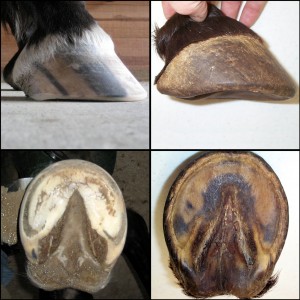 I certainly wasn’t thinking of a comparison when I took some photos of a client’s hooves the other day. As a product designer, I’m admittedly drawn to the form of a well-functioning hoof, and this older Warmblood has great feet! But as I was cropping the photos, I came across some pictures I’d taken years ago of one of Jaime Jackson’s mustang hooves, and the similarity between the two really struck me. So here they are, with the large hooves of the client on the left and the relatively small hooves of the feral horse on the right. Beautiful!
I certainly wasn’t thinking of a comparison when I took some photos of a client’s hooves the other day. As a product designer, I’m admittedly drawn to the form of a well-functioning hoof, and this older Warmblood has great feet! But as I was cropping the photos, I came across some pictures I’d taken years ago of one of Jaime Jackson’s mustang hooves, and the similarity between the two really struck me. So here they are, with the large hooves of the client on the left and the relatively small hooves of the feral horse on the right. Beautiful!